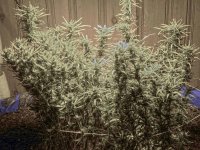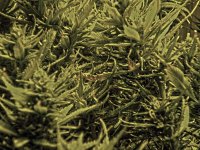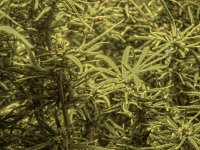-
Happy Birthday ICMag! Been 20 years since Gypsy Nirvana created the forum! We are celebrating with a 4/20 Giveaway and by launching a new Patreon tier called "420club". You can read more here.
-
Important notice: ICMag's T.O.U. has been updated. Please review it here. For your convenience, it is also available in the main forum menu, under 'Quick Links"!
You are using an out of date browser. It may not display this or other websites correctly.
You should upgrade or use an alternative browser.
You should upgrade or use an alternative browser.
Indoor, No-Till, First Run
- Thread starter descivii
- Start date
Indoor, No-Till, First Run
go by temps. mites have a faster life in high temps.
max 5 days
min 3 days
The bottle says spray every 7 days up to day before harvest but I think I've even read a 3 day spray cycle somewhere. Suggestions?
J
go by temps. mites have a faster life in high temps.
max 5 days
min 3 days
The bottle says spray every 7 days up to day before harvest but I think I've even read a 3 day spray cycle somewhere. Suggestions?
J
If after budding there are no bugs, or signs of bugs i for one, would stop spraying neem. I love neem but it does have a nasty smell that i would not want to smoke.
At that time I guess I'm still getting a modem of protection with the neem/karanja cake in the soil. And the option of a neem drench is till there. After flowering 3 weeks my maintenance spray is lavender flower water, a lot nicer smell.
Now if you only have neem and there are signs of bugs, all bets are off. But still I have finessed, good crops with sprays of tobacco, rhubarb leaf concoctions and other low cost options. At the end i still had some bugs but got in a decent crop without using heavy pesticides......scrappy
Webs on top of every cola and going down about 2". There was 2 swarms that looked like a and writhing pile of gold dust
he has an infestation, not a maintenance situation. Neem/soap/lavender needs to be applied repeatedly to wipe them out. Just spraying once, or spraying too seldom, allows them to reproduce. You need to knock out the adults, and keep knocking them out before they can lay.
There are two ways to fight mites with organic pesticides - keeping a schedule, or losing. Soap is a good miticide - you can alternate neem oil with soapy water, or start with neem and move to soap only.
At that time I guess I'm still getting a modem of protection with the neem/karanja cake in the soil. And the option of a neem drench is till there
A "modem of protection" is not going to help him. He needs at least an ethernet card of protection, and a server of offensive maneuvers.
Last edited:
descivii
Member
So here's some updated pics of the gurls. They look alot better today than they did. I can't wait for them to get done as much for the weed as gettin the room cleaned and upgraded.
J
J
Attachments
I can see mite sign in the first pics; persimilus; prevention
C
CC_2U
I've been adding the lavender tea to the neem oil, aloe vera and silica mix.Good to hear you are starting in on those little buggers. Bummer about the damage they have done, but at least you still have some plants left. Lavender is awesome and i'm alternating that with neem oil. Good luck
Lavender tea for the immediate punch as it kills on contact and the neem oil for the prevention/limiting of egg hatchings as well as its ability to disrupt the eating and reproduction cycle with herbivore insects.
CC
C
CC_2U
In a pinch you can purchase them at almost any health food store like Whole Foods in their bulk section.Where do you get the lavendar cause they grow very slowly here
Even at $42.00 per lb. (amazing) the actual cost to make 2 gallons ends up being less than $2.00
It is easily sourced online at 1,000's of sites.
HTH
CC
i got mine from a farm stand.
nice stuff.
nice stuff.
While I grow my own, to get started I bought a lb of dried flowers for $25 on amazon. They smell great, but I have not seen any bugs to see how effective it is. So I use it and the neem/karanja as maintenance. It did seem to help stop something from eating bean leafs in my veggie garden though.....scrappy
^^ lol thats why you don't have any bugs, you wont get bugs. i used the lavender for a while before learning it killed mites. mainly because i had no pests at all to see the effect it had on them.
descivii you must be REAL far north if you cant get a lavender plant to grow. even in a pot and overwinter it. its so easy to collect enough lavender blooms to last until next year. it stores well too. that or its time to build a greenhouse lol.
descivii you must be REAL far north if you cant get a lavender plant to grow. even in a pot and overwinter it. its so easy to collect enough lavender blooms to last until next year. it stores well too. that or its time to build a greenhouse lol.
descivii
Member
I could grow it in a pot but outdoors it is too wet most of the grow season and lavendar seems to stand still in ground. I'll get some going.....I think my daughter has a little plant for tea, I'll take a cutting from there.
What biological items would be necessary for an indoor self sustaining loop? How could an indoor plot become naturalized? Mycos, bacteria, pillbug, companion plants/living mulch..........what else?
J
What biological items would be necessary for an indoor self sustaining loop? How could an indoor plot become naturalized? Mycos, bacteria, pillbug, companion plants/living mulch..........what else?
J
Self sustaining loop?
A self sustaining loop is kind of a misnomer. There will be inputs and outputs but most things recycled. There are two things I think are crucial in setting up an indoor ecosystem.
1. Continuous growth. Plant the day you cut! The microbial population lives and thrives in the presense of plants roots. Disturbing or stalling root production in the soil will make things go backwards. To this end I think companions are pretty much crucial for the ideal system, just trying to iron out which ones, ML is making some ground on this in his living mulch thread. So... ideally, there are always plants (and roots!) living in your system.
2. No till. To this end ideally all your nutrition is coming in from your mulch as you are not digging things in. Soil is fed via solubles via leaching (soluble sugars, amino acids and aliphatic acids washed from mulch when you water), then all those compounds that get broken down more slowly, cellulose, hemicellulose (bacteria mainly) and lignin (fungi mainly) etc. A compound mulch is called for. One that has many elements in it. So, working on this too, I say variety, leaf mulch, grass clippings (sparingly), small sticks, broadleaf leaves dried and crushed to powder, etc. I basically scrounge things that grow around the place, to this end getting the nutritional profiles of the plants you scrounge can give you an idea of the ratios of them for your mulch. If your mulch breaks down too fast and gets hot you want less N in it. If it is breaking down too slow add N e.g. cut legumes.
A heavily mulched and companion planted bed is possibly a rough picture of ideal. What companion plant species (and what microbes and insects interact with them) will play a big part in fine tuning the concept.
Of course the original soil composition is crucial. I recommend clay, char and rock dust in all mixes when trying to do a long term thing indoors. And big, bigger is better (soil volume).
A self sustaining loop is kind of a misnomer. There will be inputs and outputs but most things recycled. There are two things I think are crucial in setting up an indoor ecosystem.
1. Continuous growth. Plant the day you cut! The microbial population lives and thrives in the presense of plants roots. Disturbing or stalling root production in the soil will make things go backwards. To this end I think companions are pretty much crucial for the ideal system, just trying to iron out which ones, ML is making some ground on this in his living mulch thread. So... ideally, there are always plants (and roots!) living in your system.
2. No till. To this end ideally all your nutrition is coming in from your mulch as you are not digging things in. Soil is fed via solubles via leaching (soluble sugars, amino acids and aliphatic acids washed from mulch when you water), then all those compounds that get broken down more slowly, cellulose, hemicellulose (bacteria mainly) and lignin (fungi mainly) etc. A compound mulch is called for. One that has many elements in it. So, working on this too, I say variety, leaf mulch, grass clippings (sparingly), small sticks, broadleaf leaves dried and crushed to powder, etc. I basically scrounge things that grow around the place, to this end getting the nutritional profiles of the plants you scrounge can give you an idea of the ratios of them for your mulch. If your mulch breaks down too fast and gets hot you want less N in it. If it is breaking down too slow add N e.g. cut legumes.
A heavily mulched and companion planted bed is possibly a rough picture of ideal. What companion plant species (and what microbes and insects interact with them) will play a big part in fine tuning the concept.
Of course the original soil composition is crucial. I recommend clay, char and rock dust in all mixes when trying to do a long term thing indoors. And big, bigger is better (soil volume).
descivii
Member
Fista,
By self-sustaining I meant as opposed to purchasing amendments every cycle.
For the mulch I've been collecting just that, a menagerie of greens.....some rapid growing shit and some slow, some green, some brown, even some flowers. Just a general yard mix really but my yard has been chem free for more than 10 years and neighbors are too lazy to apply or do anything in their yard.
For soil composition actually, it came to me last night that I might do well to bury some natural clay chunks toward the bottom for roots to mine naturally. Perhaps amend the clay chunks with some of the loess soil I mentioned in another thread or azomite ......something like that so the roots can do root things. Afterall, at least around here there is pretty intense red and gray clay about 2-3' down.
J
By self-sustaining I meant as opposed to purchasing amendments every cycle.
For the mulch I've been collecting just that, a menagerie of greens.....some rapid growing shit and some slow, some green, some brown, even some flowers. Just a general yard mix really but my yard has been chem free for more than 10 years and neighbors are too lazy to apply or do anything in their yard.
For soil composition actually, it came to me last night that I might do well to bury some natural clay chunks toward the bottom for roots to mine naturally. Perhaps amend the clay chunks with some of the loess soil I mentioned in another thread or azomite ......something like that so the roots can do root things. Afterall, at least around here there is pretty intense red and gray clay about 2-3' down.
J
Sounds good. You can bust the clay up in the original mix though, nature can take centuries to create an ecosystem we need to speed it up a bit...
The clay adds to physiochemical properties it's charged groups bind with microbes making real estate for them. They get enzymes out into the clay and mine minerals for you.
Azomite also sounds good. Real good. Add the loess too, some sand and silt if you got it. Silt from a pond is good but don't go below a few cm you'll get problems the anaerobic layer beneath is undesirable.
All sounds really good, will drop in now and then see how things are working out for you. Feel free to question me.
The clay adds to physiochemical properties it's charged groups bind with microbes making real estate for them. They get enzymes out into the clay and mine minerals for you.
Azomite also sounds good. Real good. Add the loess too, some sand and silt if you got it. Silt from a pond is good but don't go below a few cm you'll get problems the anaerobic layer beneath is undesirable.
All sounds really good, will drop in now and then see how things are working out for you. Feel free to question me.
descivii
Member
As a teenager I kept reptiles and enjoyed creating lush terrariums trimmed in bamboo and so on.....but no matter how self-sufficient a terrestrial or epiphytic habitat was I always had to add nutrients from outside because a caged ecological niche is terribly hard to sustain but I think as Fista and a few others mentioned in the threads that inspired me is that size will matter. So far I also have left myself 6" low so that I can accumulate soil and debris with time without overflowing.
On a side note I can see leaves being devoured by tiny white hairs with tiny caps on them
J
On a side note I can see leaves being devoured by tiny white hairs with tiny caps on them
J








